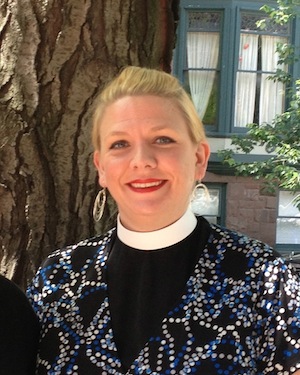
Hymns are a powerful form of discourse. Along with other acts of worship, it is through hymns that our theological beliefs begin to be shaped. Indeed, it may be that hymns—out of all the forms of discourse in a traditional worship service (e.g., sermon, scripture reading, prayers)—have the greatest influence upon our theological development, even if such development occurs unconsciously. As we become familiar with a particular series of words set to certain melodies, repeated often as we worship regularly, we become attached to the specificity of the lyrics. Consequently, the meaning of these lyrics begins to mold our own thought. If Judith Butler argues that gender is performed, instituted through a “stylized repetition of acts,” then are not hymns also a stylized repetition that perform, and thus inform, our beliefs?[1] Therefore, hymns are a mode through which we perform gender, repeating the refrain of our thoughts about gender—human and divine, theological, social, and biological—until they become the norm. As such, what we sing—and what we choose to sing—communicates gendered ideologies to ourselves and to others and thus informs our social and theological actions.
So, how can a hymnal communicate gender justice? And, more specifically, how does Glory to God: The Presbyterian Hymnal do so? Here, I will focus primarily on language used to describe God and the messages such language conveys about gender, human or divine (but one could equally focus upon depictions of human gender and of humanity, perhaps in particular the ways in which hymns conform to and/or deviate from social and biological gender binaries). In its “Statement on Language” (Appendix 2), the Presbyterian Committee on Congregational Song declares of the hymnal’s language used for God, “The collection will emphasize that the God who meets us so graciously and intimately in salvation history is at the same time one who is wholly other and beyond gender” (929). This collection of hymns, based upon this description and my own perusal of the wide variety of new and traditional songs, indeed provides significantly more alternatives to traditional (masculine) imagery of God than can be found in previous collections.
___________________________________________
But, perhaps a more pressing question is: what precisely does it mean for this collection to emphasize a God beyond gender? Is “beyond” to mean “without” – that the hymns we sing should mostly emphasize God’s actions or God’s qualities that are assumed to be non-gendered?
___________________________________________
![]() To be sure, masculine imagery for God can still be found. For example, God is described as a “king” (to my knowledge, no hymn has yet hailed praise to God the Queen), and though such an image may capture God’s majesty, it still captures God in a male role. I focus on this particular male image because it is one that occurs in some of the most cherished and familiar of traditional hymns, such as one of my personal favorites, “All Creatures of Our God and King” (#15). Even more, however, it is also a lyric that is most difficult to change not only due to its familiarity but also because it tends to end a stanza, thus provided a perfect rhyme with words like “sing.” While there are still these examples of traditional male imagery in the new hymnal, the hymnal does tend to balance these instances with hymns that laud female imagery for God. “Come, Thou Almighty King” (#2) appears immediately prior to “Womb of Life and Source of Being” (#3), a newer hymn (text by Ruth Duck, 1986) whose first verse emphasizes God’s creating power using mothering imagery. Likewise, “Mothering God, You Gave Me Birth” (#7), a hymn derived from the writings of fourteenth-century mystic Julian of Norwich that uses maternal imagery for God, Christ, and Spirit, precedes the triumphantly male-centered “Eternal Father, Strong to Save” (#8). Though it seems that still more male images occur than female (and maternal imagery seems to dominate, almost exclusively, these female images), such pairing does introduce more variety to our language and helps interrupt the tendency for hymns to speak of God in only masculine or non-gendered terms.
To be sure, masculine imagery for God can still be found. For example, God is described as a “king” (to my knowledge, no hymn has yet hailed praise to God the Queen), and though such an image may capture God’s majesty, it still captures God in a male role. I focus on this particular male image because it is one that occurs in some of the most cherished and familiar of traditional hymns, such as one of my personal favorites, “All Creatures of Our God and King” (#15). Even more, however, it is also a lyric that is most difficult to change not only due to its familiarity but also because it tends to end a stanza, thus provided a perfect rhyme with words like “sing.” While there are still these examples of traditional male imagery in the new hymnal, the hymnal does tend to balance these instances with hymns that laud female imagery for God. “Come, Thou Almighty King” (#2) appears immediately prior to “Womb of Life and Source of Being” (#3), a newer hymn (text by Ruth Duck, 1986) whose first verse emphasizes God’s creating power using mothering imagery. Likewise, “Mothering God, You Gave Me Birth” (#7), a hymn derived from the writings of fourteenth-century mystic Julian of Norwich that uses maternal imagery for God, Christ, and Spirit, precedes the triumphantly male-centered “Eternal Father, Strong to Save” (#8). Though it seems that still more male images occur than female (and maternal imagery seems to dominate, almost exclusively, these female images), such pairing does introduce more variety to our language and helps interrupt the tendency for hymns to speak of God in only masculine or non-gendered terms.
 But, perhaps a more pressing question is: what precisely does it mean for this collection to emphasize a God beyond gender? Is “beyond” to mean “without” – that the hymns we sing should mostly emphasize God’s actions or God’s qualities that are assumed to be non-gendered? For such an emphasis, one could look to a traditional hymn like “Immortal, Invisible, God Only Wise” (#12), which portrays God as exceeding all limits of human experience. Though gender is not mentioned specifically, it is easy to imagine an additional verse, at least one that is implicit in the hymn’s theology: “No gender, nor race, nor sexual orientation.” Such a hymn implies the equation of “beyond gender” with “without gender;” it implies that we experience human identity as a limitation that must be transcended. In such terms, a God who is “beyond gender” transcends gender difference by negating it.
But, perhaps a more pressing question is: what precisely does it mean for this collection to emphasize a God beyond gender? Is “beyond” to mean “without” – that the hymns we sing should mostly emphasize God’s actions or God’s qualities that are assumed to be non-gendered? For such an emphasis, one could look to a traditional hymn like “Immortal, Invisible, God Only Wise” (#12), which portrays God as exceeding all limits of human experience. Though gender is not mentioned specifically, it is easy to imagine an additional verse, at least one that is implicit in the hymn’s theology: “No gender, nor race, nor sexual orientation.” Such a hymn implies the equation of “beyond gender” with “without gender;” it implies that we experience human identity as a limitation that must be transcended. In such terms, a God who is “beyond gender” transcends gender difference by negating it.
I raise such questions because, as I asserted above, hymns perform our beliefs about God’s gender and they form and inform our own thoughts and performances of gender in our congregations, our communities, and our world. The God described only in male terms (as was typical of hymnals of past generations) informs a theology and a social world in which men dominate. (Likewise, one could argue that a God described as a lord/kurios potentially informs a theology in which God sides with the upper classes.[2]) While a God fully beyond/without gender avoids a God-become-male, a God entirely beyond gender tends to ignore the realities, messy as they may be, of gender in all its rich variety. If God is “beyond gender,” how can we, “male and female” “in God’s image” (cf. Genesis 1:26-27; also Galatians 3:28), allow our experiences of God to inform and transform our social realities, specifically those related to gender?
Thinking specifically about gender justice, then, if God is beyond hierarchies based on gender distinctions or binaries, then God herself/himself cannot be fully without gender (for, far too often, “without gender” defaults to perpetuating male privilege). To this end, I will highlight two newer hymns that I find particularly helpful for such a project. The first, “Bring Many Names” (#760), explicitly identifies God as multifaceted, including the embodiment of more than one gender. In this hymn, God is called “strong mother” and “warm father,” in addition to being both youthful and aged. Though typical parental imagery is maintained in the hymn, the lyrics do not stereotype maternal or paternal roles. Further, the title and the theme of the hymn celebrate the plurality of names for God, teaching those who sing it and hear it that God’s identity—and, implicitly, human identity—is multiform. While it cannot be reduced to any single name, neither can it be said to have moved entirely beyond these identities. Instead, the hymn implies that God encompasses all of these names and many more beside.
 The second hymn, “Sacred the Body” (#27), does not directly discuss God’s attributes/identity (as those previously discussed do), but it offers a powerful vision of bodies as God’s creation, and it portrays a God who intentionally creates and loves different and multilayered identities. The hymn affirms and includes a wide variety of bodily difference – affirming differences in gender, race, size, and sexuality – and calling all this “holy” and a gift of God in creation. It is the third verse, however, that provides this hymn with a call to justice based on such affirmations: “Love respects persons, bodies and boundaries. Love does not batter, neglect, or abuse. Love touches gently, never coercing. Love leaves the other with power to choose.” In such phrasing, the hymn takes a stand against domestic violence and rape culture, both symptoms of gender injustice, and creates a framework that calls us as Christians, each crafted lovingly in God’s image, to appreciate and to respect all others similarly created.
The second hymn, “Sacred the Body” (#27), does not directly discuss God’s attributes/identity (as those previously discussed do), but it offers a powerful vision of bodies as God’s creation, and it portrays a God who intentionally creates and loves different and multilayered identities. The hymn affirms and includes a wide variety of bodily difference – affirming differences in gender, race, size, and sexuality – and calling all this “holy” and a gift of God in creation. It is the third verse, however, that provides this hymn with a call to justice based on such affirmations: “Love respects persons, bodies and boundaries. Love does not batter, neglect, or abuse. Love touches gently, never coercing. Love leaves the other with power to choose.” In such phrasing, the hymn takes a stand against domestic violence and rape culture, both symptoms of gender injustice, and creates a framework that calls us as Christians, each crafted lovingly in God’s image, to appreciate and to respect all others similarly created.
___________________________________________
“Sacred the Body” affirms and includes a wide variety of bodily difference – affirming differences in gender, race, size, and sexuality – and calling all this “holy” and a gift of God in creation.
___________________________________________
Ultimately, I am uncertain whether a hymnal, as a vast collection of holy songs to be used in a variety of contexts for a diverse denomination, can properly do justice. Perhaps, in my own estimation, this is because hymnals are a bit like the Bible. Within both collections, there are texts with immense potential for communicating and fostering a sense of justice, and there are texts which can be—and indeed have been—used to support unjust causes, specifically here those which participate in a discourse that imposes and reinforces patriarchal and/or kyriarchal gender roles and binaries. That being said, standing alone, no single hymn in this collection promotes gender injustice or inequality; indeed, many of the hymns explicitly contain messages that enact or allow for gender justice. It is, finally, our responsibility to use this hymnal to foster such justice. The hymnal brings many messages, and it is up to us to decide which hymns we will sing. The sets of hymns we repeatedly choose to sing ultimately determine whether Glory to God communicates gender justly.
[1] Judith Butler, Gender Trouble: Feminism and the Subversion of Identity (New York: Routledge, 1990, repr. 2006), 191.
[2] The hymnal’s “statement on language” disagrees with such an implication, though the committee appears to be aware of Elisabeth Schüssler Fiorenza’s neologism “kyriarchy,” rule of the lord/master, which observes that issues of gender are always intertwined with other social hierarchies based on class, gender, sexual orientation, etc. See, for example, In Memory of Her: A Feminist Theological Reconstruction of Christian Origins (New York: Crossroad, 1983); (Minneapolis: Fortress Press, 2007).
AUTHOR BIO: James N. Hoke is getting his Ph.D. in New Testament and Early Christianity in the Graduate Division of Religion at Drew University’s Theological School. There, his work focuses on queer and feminist theories in and around Paul’s letters, and he is also an adjunct instructor of Koine Greek. He holds an M.Div. from the University of Chicago, and he serves as the Director of Christian Education at the Presbyterian Church of Madison, NJ (where he is also a loyal choir member).
***
More from Advent I: HOPE for Gender Justice.
Read more articles in this series.






Unbound Social